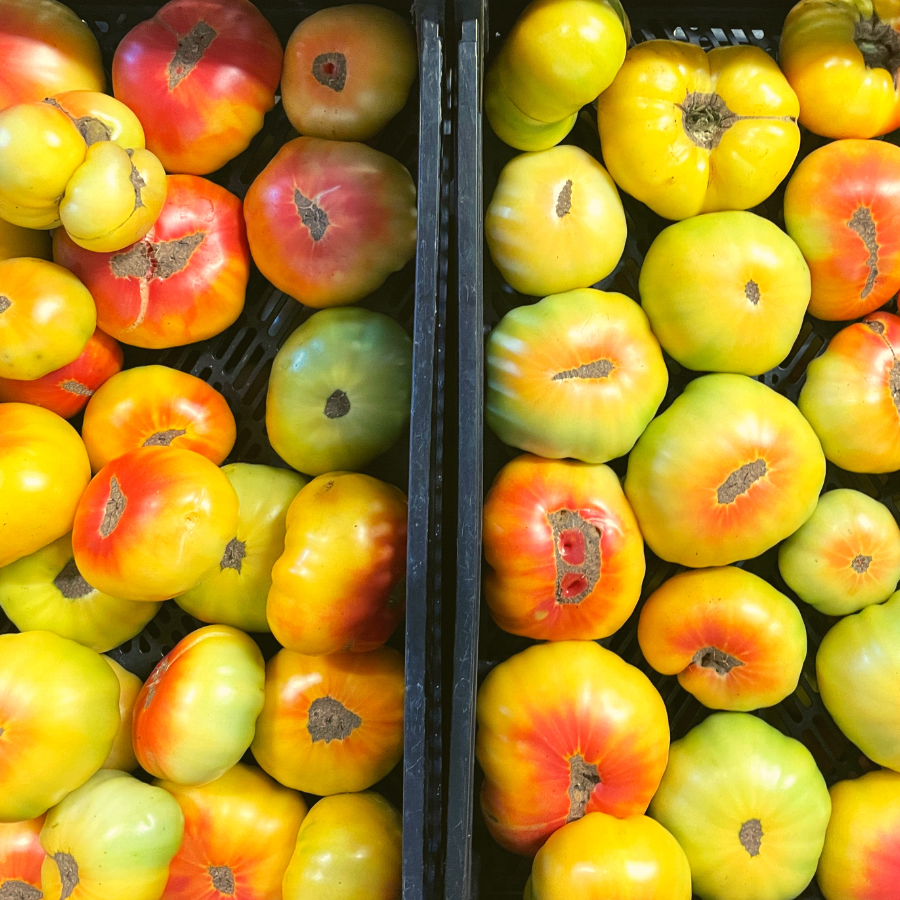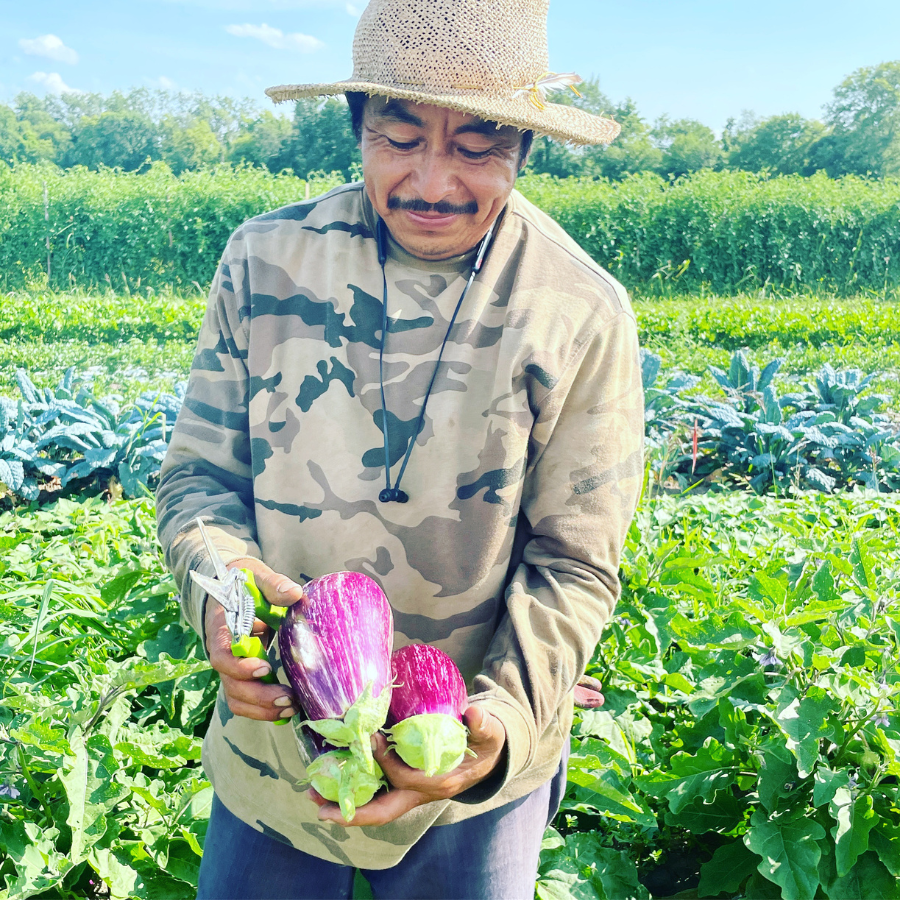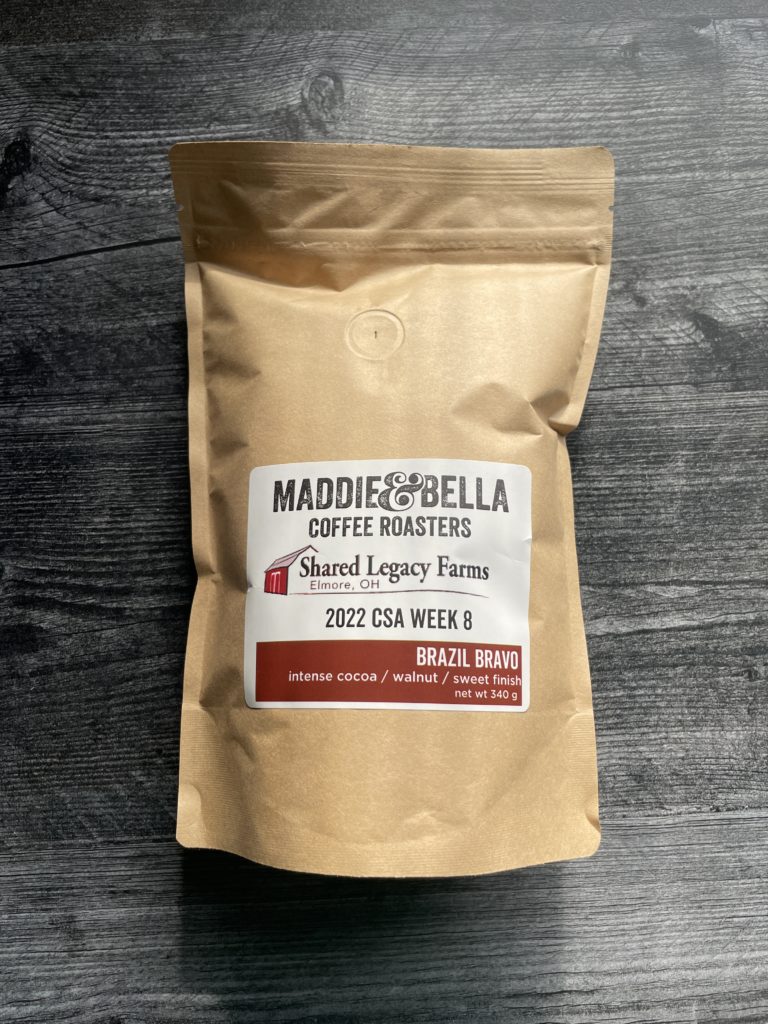CSA Newsletter Week 8 (August 7-13, 2022)

Jose, Jesus, Polo, Pedro, Noah, and John — our harvest crew show off their melon varieties!
Farm Newsletter Week 8
August 7-22, 2022 | “B” Week
What’s in the Box this Week?
POTATOES (1 heaping quart ) from Mile Creek Farm ~ Keep unwashed potatoes in a cool, dark, dry place, such as a loosely closed paper bag in a cupboard. They will keep for two weeks at room temperature. Light turns them green, and proximity to onions causes them to sprout. Don’t put them in the refrigerator, as low temperatures convert the starch to sugars. To prep: Scrub well and cut off any sprouts or green skin. Peeling is a matter of preference. In soups, the skins may separate from the flesh and float in the broth, but when baked, pan- fried or roasted, the skins acquire a crisp, crunchy texture. To cook: Boil potatoes in water for 20-30 minutes until tender. If desired, mash them. Use potatoes in soups, hash browns, and salads. Roast sliced or whole small potatoes with fresh herbs, salt, and olive oil at 400 degrees until tender, about 20 minutes.
PARSLEY ~ For short-term storage, stand upright in a container with an inch of water. Then cover the herbs loosely with a plastic bag and refrigerate for up to 2 weeks. To prep: Chop the leaves and stem before cooking. The stem can be used to flavor soups and stews too.
You can dry parsley!… Place a piece of paper towel on a glass plate. Layer the parsley evenly around the plate being sure not to overlap. Cover with another piece of paper towel. Microwave on high for 1 minute. Leaves will be dry. Crinkle them with your finger and place them in a dry container, such as a Mason jar with a lid. To freeze: Chop parsley finely and freeze in ice cube trays with water. Pop out frozen cubes and freeze in a freezer bag.
TOMATOES (3) ~ You will receive one heirloom and 2 smaller salad tomatoes. Heirloom tomatoes will have cracks and weird shapes to them. They should be eaten on the first or second day, as they have a very low shelf life — but incredible flavor!! To store: Do not refrigerate tomatoes. Store them at room temperature out of the sun stem side down. Putting them in a paper bag will accelerate the ripening process. Heirloom tomatoes will have strange shapes and cracks. These are highly perishable and should be eaten within 1-2 days. To prep: If you’ll be cooking tomatoes, consider removing the skins so they don’t float around in your dish. To do so, score the end of the tomato with an “X,” dunk whole tomatoes in boiling water for 30 seconds, lift out with slotted spoon, plunge into ice water, and the skins will slide off. To freeze: Tomatoes can be frozen whole with the skin on. The skins will slide right off when they thaw. Simply pop the washed tomatoes whole into a Ziplock bag. Thawed tomatoes are appropriate only for cooking sauces, salsas, or purees.
CHERRY TOMATOES (1 pint) ~ Store these at room temperature on your counter. Wash before eating. Eat them out of hand or try roasting them. Toss them in a salad. Add them to shish-kebob!
SWEET BANANA PEPPERS (2) ~ To store: Refrigerate peppers unwashed in a sealed plastic bag in the crisper drawer for 1-2 weeks. To prep: Cut in half and remove the seeds from the inside. Slice, chop or mince. To use: Use as you would a bell pepper! Or try roasting peppers over a flame until the skin blackens. Place the pepper inside a plastic bag to cool. Then remove to slide off the skins. To freeze: Wash and dry peppers. Freeze whole or cut into bite-size pieces and place in Ziplock freezer bag, removing as much air as possible.
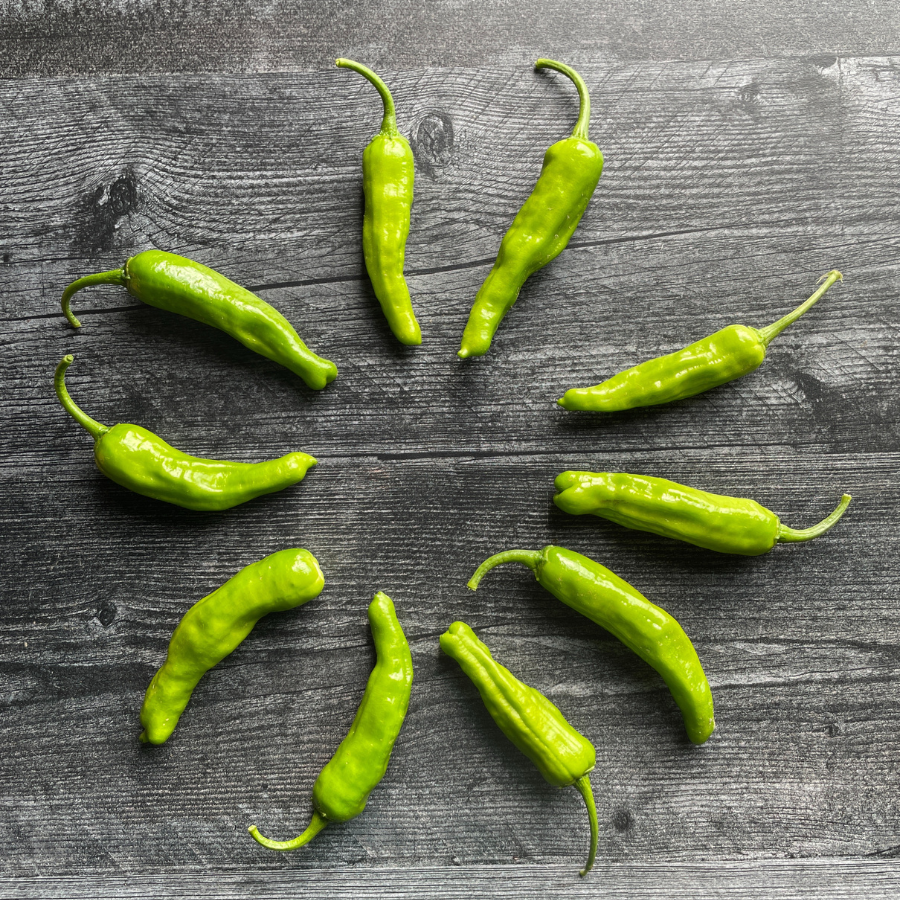
Shishito peppers
SHISHITO PEPPERS (5) ~ These peppers are fun! Roughly 1 out of 10 of them are hot! The rest taste like a regular pepper. So it’s a little bit like playing Russian Roulette. To store: Refrigerate peppers unwashed in a sealed plastic bag in the crisper drawer for 1-2 weeks. You can also dehydrate peppers for long-term. To freeze: Wash and dry. Keep whole, or cut into bite-size pieces and place in Ziplock freezer bag.
GREEN BELL PEPPERS (2) ~ To store: Refrigerate peppers unwashed in a sealed plastic bag in the crisper drawer for 1-2 weeks. To prep: Cut in half and remove the seeds from the inside. Slice, chop or mince. Try making stuffed peppers! (These can also be frozen). To freeze: Wash and dry peppers. Freeze whole or cut into bite-size pieces and place in Ziplock freezer bag, removing as much air as possible.
EGGPLANT (1) ~ Wrap unwashed eggplant in a towel (not plastic) to absorb any moisture, and keep it in the veggie drawer of your refrigerator. Or store unrefrigerated at a cool room temperature. Use within a week and it should still be fresh and mild. To prep: Eggplant is usually peeled. The flesh will brown when exposed to air. To prevent browning, coat in lemon juice or keep submerged in water. To use: Brush 1/2-inch to 1-inch slices of eggplant with olive oil or melted butter and broil or grill until brown. It also makes an excellent baba-ganoush dip. To freeze: Peel and cut into slices 1/3-inch thick. Blanch for 2 minutes in steam. Cool immediately in cold water. Package in layers with each slice separated with two pieces of wrap.
Grab my Eggplant E-Book here for other suggestions for recipes using eggplant.
SWEET CORN (6) (not organic, non-GMO) ~ To store: Refrigerate sweet corn as soon as possible with husks on. The longer you wait to eat it, the more sugar will turn into starch, and the corn will lose its \ sweetness. To prep: You can eat corn raw or cook it in the husks. Shuck the cob by pulling the husks down the ear and snapping off the stem. The silks will fall off as you cook the corn. Rinse under cold water. If you see a green worm, just cut out the damaged section — the rest of the cob is still edible! To cut the kernels off the cob, stand the cob upright on its base and run a sharp knife from the tip of the ear down to the base. To cook: Steam corn in 1-2 inches of water for 6-10 minutes, or drop ears into boiling water for 3-6 minutes. Season with butter or salt. You can also grill corn in the husk — place the corn in its husk in water for 10 minutes — then place on grill for 15 minutes. To freeze: Blanch on the cob for 3-5 minutes, rinse under cold water, and drain. Cut off the kernels with a knife, and then pack it into airtight freezer containers.
GREEN CUCUMBER (1) ~ Cucumbers are in a family known as cucurbits that includes melons, squash, pumpkins and gourds. They are classified as either slicers or picklers. Pickling cucumbers have thin, lighter skin than slicers. To store: Place cucumbers in a sealed plastic bag in the crisper drawer of the refrigerator for up to a week. To prep: Slicing cucumbers are often peeled. Pickling cukes are not. If the seeds are bulky, slice the cucumber lengthwise and scoop them out. Scoring the skin of a cucumber with a fork or zester gives it attractive stripes. Slice, dice or cut into chunks according to recipe. To freeze: You can freeze cucumbers in a vinegar brine, but they will be mushy when you eat them later. Not recommended.
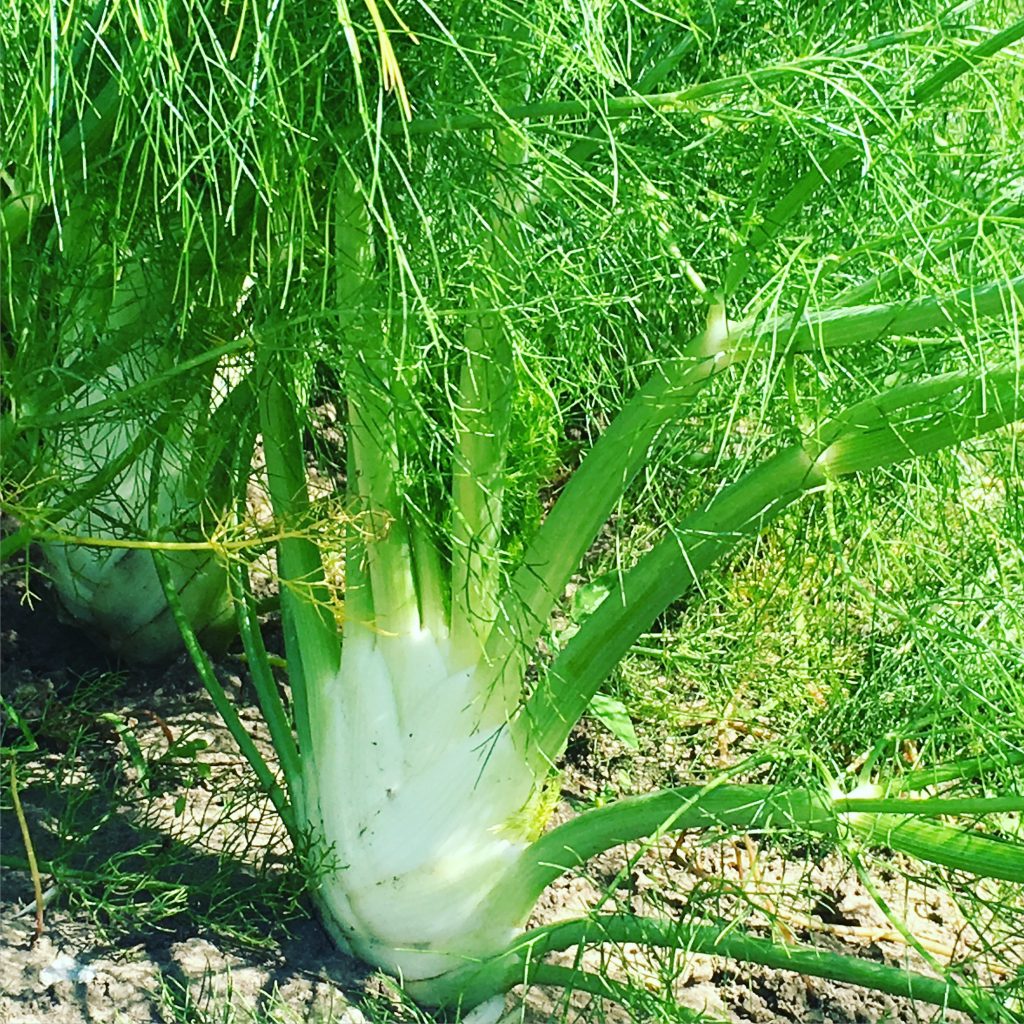
Fennel is one of the crops that we will buy in from another farm this year.
FENNEL (2 small) ~ Both the fronds and the bulb are edible. Fennel has a distinct licorice taste. To store: Cut off the stalks where they emerge from the bulb, and if you want to use the feathery foliage as an herb, place the dry stalks upright in a glass filled with two inches of water. Cover the glass loosely with a plastic bag and store in the refrigerator for few days. The unwashed bulb may be kept in a plastic bag in the refrigerator drawer for 2 weeks. To prep: Remove the tip base of the white bulb. Cut off the stalks. Chop or mince the stems and leaves for garnish or seasoning. To use: Try fennel raw: brush raw slices with olive oil and lemon juice, sprinkle with salt and pepper and serve as an appetizer. Use the fernlike tops as a licorice-flavored herb or garnish. Use the stems in soup stocks in place of celery. Grill, braise, or roast fennel. The feathery leaves are great on baked or broiled fish with butter and lemon. To freeze: Cut bulb into quarters and blanch in boiling water for 1 minute. Then plunge into ice water for 1 minute. Drain and freeze in Ziplock bags.
Need some help with fennel? Download my free Fennel E-Book here for more tips and recipes.
KALE ~ To store: Place kale unwashed, wrapped in a sealed plastic bag in the crisper drawer of the refrigerator. Best used very fresh, but may last for a week. To prep: Wash leaves in basin of lukewarm water to remove grit. If your greens have thick stems, you must remove them. Fold each leaf in half and slice out the stem. Then stack the leaves up and slice them diagonally into 1-inch-wide strips. To use: Saute in olive oil. Use in soups, spaghetti sauce, pesto, quiche, or kale chips. You can also eat the stems. To freeze: Blanch washed greens for 2-3 minutes. Rinse in cold ice water to stop the cooking process, drain, and pack into airtight containers. Stems can also be frozen.
SUMMER SQUASH MIX (2 pieces) ~ This will be a mix of either green zucchini, yellow crookneck, patty pan (looks like a flying saucer), and Zephyr (yellow squash with a lime green tip). To store: Store squash unwashed in a perforated plastic bag in the vegetable bin. In the refrigerator they keep for about a week. To prep: Rinse under water to remove the dirt or prickles, and slice off the stem and blossom ends. Then slice or chop. Scrape out seeds from baseball bat sized zucchinis before using them to bake. To use: Slice tender, young summer squash raw into salads. Try them in stir-fry or with pasta. Lightly steam (4-5 minutes) and dress them with fresh herbs or pesto. Or coat squash lightly in oil and roast at 350 degrees whole or sliced in half for 15-45 minutes. Stuff whole squash with your favorite stuffings. Bread them and make zuke fries. To freeze: You can freeze grated zucchini for use in breads and muffins. Squeeze as much liquid out as possible before adding to the freezer bag.
WEEK #8 ADD-ON SHARES: Week “B”
Odd-numbered weeks of our CSA season (week 1,3,5) are called “A” weeks. And even-numbered weeks (week 2,4,6) are called “B” weeks. If you have any kind of non-veggie, bi-weekly share, you have been assigned to either “A” or “B” week for the season. If you get a cheese share, it always comes on Week “A.”
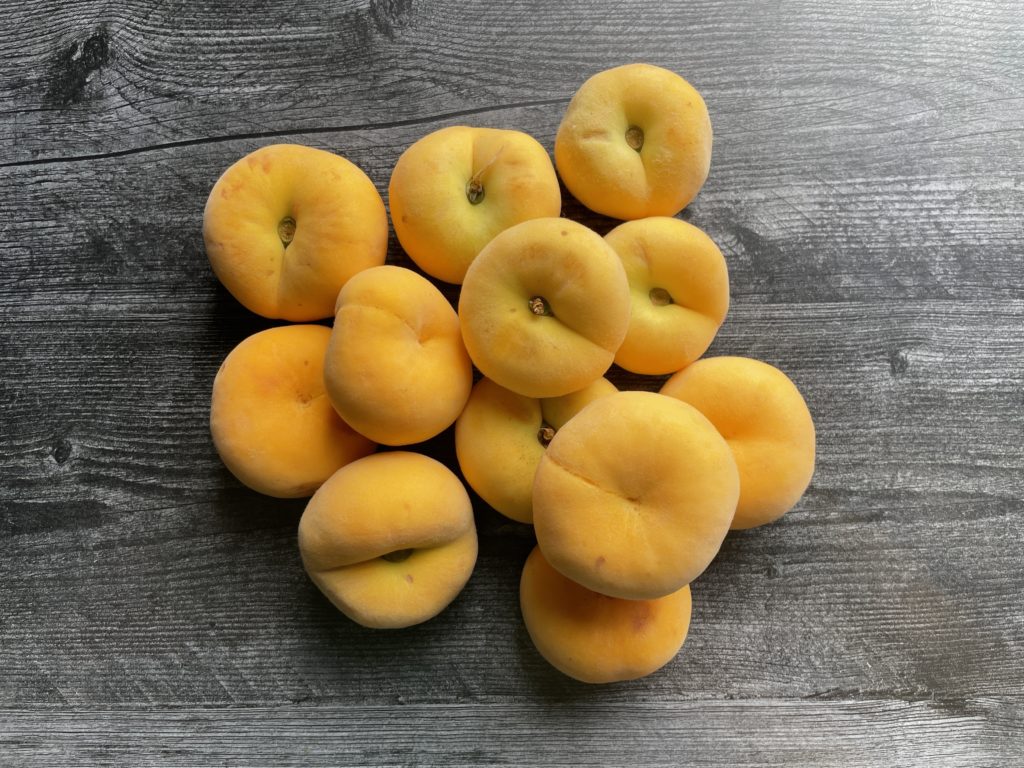
This is a donut peach. It has a flying saucer type feel to it. And it’s very juicy and sweet! It’s our boys’ favorite peach!
WEEK 8 FRUIT SHARE:
YELLOW NECTARINES ~ To store: If your nectarines are not yet ripe, store them out of the sunlight on the countertop until they are soft and aromatic. Once they are ripe, place them in a plastic bag in the fridge. If you put unripe nectarines in the fridge, you will stop the ripening process! Use ripe nectarines within a week. To prep: Wash. Remove the pit inside.
DONUT PEACHES ~ These will have a flattened appearance – like a donut! Peaches are ripe when they are rich in color, plump, and soft along the seam of the fruit. To store: If your peaches are still firm, store them out of the sunlight on the countertop until they are soft and aromatic. Once they are ripe, place them in a plastic bag in the fridge. To prep: Wash and remove the pit inside.
CANTALOUPE MELON (Bench Farms, St. Rte. 2)~ To store: If your cantaloupe melon seems a bit short of ripe, keep it at room temperature for a few days until there is a sweet smell coming from the stem end. Once the melon ripens, then store it in the refrigerator. Cut melon should be covered in plastic wrap. To prep: A big knife and cutting board are helpful. Cut in half, scoop out the seeds, then cut into quarters or slices. Remove the rind.
Ice Cream Flavor of the Week:
Blueberry Sweet Corn! from Knueven Creamery. Note: be sure to stop and pick up your ice cream from the Knueven milk truck at your pickup site! They will be located either right before or after your veggie pickup. Your farmers will not be passing this out in their delivery line.
Coffee Flavor of the Week:
Brazil Bravo: Maddie & Bella Coffee Company ~ intense cocoa, walnut, sweet finish
FARMER KURT’S FIELD NOTES
Corinna’s other brother, Sven, from Portland, OR, came out to visit this Monday-Thursday. He brought two of his kids along – James (6) and Jack (9). Jed and Josiah haven’t spent much time with their cousins due to the long distance, so this was a little bit of a “get-to-know-you” trip. Unfortunately, I wasn’t able to spend as much time with them as I would have liked with all the farm work, but Corinna and the boys took them to Zoo, and the swimming hole at White Star Park. I also got to see the Minions movie with them the day they left. They did enjoy roaming the farm, checking out the fort, snacking on some veggies, playing on the trampoline and tire swing, getting eggs from the chickens…. It was hot for them though. They took lots of water breaks.

Kurt, Josiah, Jack Louis, James Louis, Sven Louis, and Jed outside the movie theater
We got about 1/2 inch of rain this week — which was great. Our stuff needed it. I still could use a little bit more water, so I’ll be irrigating this weekend. My big job last week was getting the drip irrigation installed. If you recall, I talked in a different newsletter about the big process it is to set up the main irrigation lines — those are the big aluminum pipes, and lay-flat hose (aka fireman hose) that bring water to the beds. But then there’s still the drip irrigation line, which needs to be connected to those main lines. I’ve been putting it off cuz I hate doing it, and it’s a big full-day job. But I finally moved it to the top of my list and made it happen. Of course, as soon as I did, it rained. That’s how it goes.

Jed is driving the tractor, seeding beets in this photo. That’s Kurt walking behind the machine.
Jed helped me seed more fall carrots and beets with the vacuum seeder this Thursday. We sowed 12 beds! He did a great job. This is a pretty complicated machine, and he is learning how to do it. Soon I’ll be able to rely on him to do some of these tasks for me. I’ve also got most of the spring crops out of the beds, and have turned them over into cover crops to keep the soil going. Summer squash and cucumbers are on their way out. They’ve shucked out an incredible amount of fruit for me! The trellising system definitely works better. I’ll actually be able to dial back how much I plant next year if I can get those kind of yields. Soon tomatoes and peppers will take center stage, and so the timing will be perfect. Almost daily cucumber/squash harvest will be replaced with regular tomato and pepper harvesting. I hope you’re ready for pepper-palooza!

The new equipment barn is now finished!
The new equipment barn is now complete! It was finished last week. I’ve started moving my equipment into it. This will help us extend the life of our investment by keeping things out of the rain, where they can start to rust. Over our 15 years, I’ve slowly been collecting key pieces of equipment that each create efficiencies in harvest or production or soil health. Corinna tells me to stop buying more equipment. But there’s always something on the list, isn’t there? (Next year: we HAVE to get a bigger box truck. I can’t fit all the stuff inside for Perrysburg site!)
Sorry about the cut lettuce snafu last week. I wasn’t too proud of the quality we put into the Tuesday box. And by Thursday, I just decided we shouldn’t even put it in the box at all. I have a hard time growing cut lettuce in the heat of the summer. It just doesn’t want to germinate, or it bolts in the heat. I’ve got some “Amaranth” coming on soon — this is a new variety of summer green for us that tastes a lot like spinach. It’s already growing super fast.
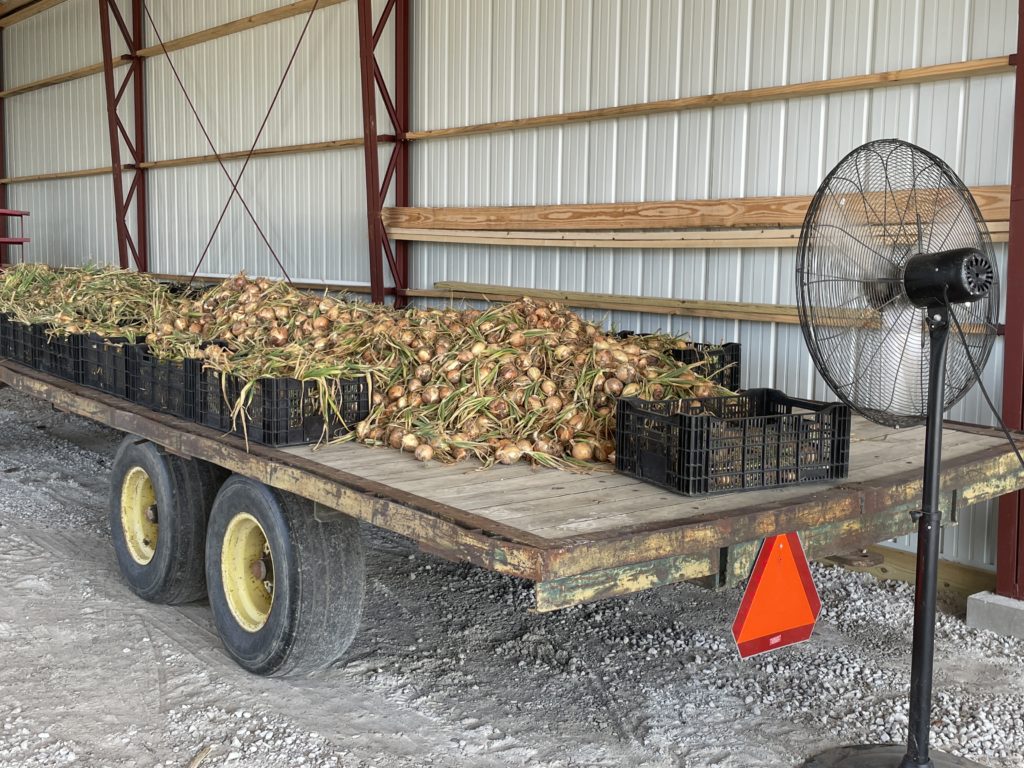
Onions are curing inside our newly completed equipment shed.
The crew harvested MORE storage onions this week — a big job that just keeps on going! (We have a lot of onions out there). I throw them on a wagon and put a fan on them. The new tan barn is the perfect place for them right now — with both doors open and a fan, it’s actually very cool inside.
I got to use my “new-to-us” onion topper machine this week. We bought this last year and modified it with some safety railings. It quickly removes and cleans up all the skin and tops off cured onions. (These will go into long-term storage and we’ll pull from them throughout the season). You can watch the short video above to see how it works. It’s still a scary machine though — a finger or piece of loose clothing can get caught in the moving parts and pull you in, so this is definitely a machine to be careful around.
It’s HOT out this week. My crew is staying hydrated and eating lots of popsicles, courtesy of our CSA member “Ice Cream Fairies.” All this heat is great for our melons though. Cantaloupes are just about done. The small mini “sugar cube” melons are next — they look like miniature versions of cantaloupes and are super-sweet! Watermelons will follow. I’ve also got canary melons in the mix.

We went tubing with the Markley’s on Friday in Ann Arbor. They are also CSA members!
I was able to get away on Friday and go tubing at Argo Park in Ann Arbor with our friends, the Markleys. Our boys have struck up a friendship with their girls (cough, cough), and we really enjoy spending time with them. Did you know there was a free place to go tubing in Ann Arbor? Check it out. It’s awesome.
~Your Farmer, Kurt
Order Your Field to Table Dinner Tickets
Date is Sept. 10th at the farm
You can now place your reservations for our final Field to Table dinner, to be held on Sept. 10. You may arrive at 5 PM to stroll our fields and take one of our 3 scheduled tractor hay ride tours. Dinner begins at 6 PM. Dress comfortably — it may get a bit chilly when the sun sets. This event will be catered by Cork and Knife Provisions (Chef Joseph Jacobsen –formerly of Degage Jazz Cafe), and will be held outside in the middle of our field. It will be a sit-down meal, served by a wait staff.
The menu include 5 courses, which you can see below. Fizzitap Vintage Beverage Truck will also be in attendance, ready to serve you 2 fun mocktails from 5-8 PM at no extra charge. No alcohol will be served. However, you are encouraged to bring your own beer or wine. Tickets are $75/person. To place your reservation, head to this link to pre-pay. You may at that time also request a vegetarian option if needed. Tickets are first-come, first-serve. You are welcome to invite friends who are not in the CSA.
View the menu at this link.
To place your reservation, head to this link to pre-pay.
Take the Shishito Pepper Challenge!
August 9-16, 2022 | #shishitochallenge
Have you ever heard of a Shishito pepper? These are fun members of the pepper family because roughly one out of 10 of them are spicy! It’s kind of like playing Russian Roulette with a pepper. For the first time ever, we’re including them in your CSA share for week 8! And to celebrate, we thought we’d have a little fun…
We’ve having a fun contest this week called the Shishito Pepper Challenge.
Here’s how it works: You will get 5 shishito peppers in your box. We dare you to try one and see if it is spicy! Just cut off a small portion and take a nibble. Then post your results in our Facebook group by snapping a picture of you eating the pepper OR a just picture of your nibbled pepper for proof! If you’re REALLY brave, and/or you have a lot of family members, you can give EACH of them a pepper to try, and see who gets the lucky one! Have some milk standing by in case you hit the jackpot!
To be clear: All you have to do to enter the contest is to post a picture of you trying ONE of your five peppers. It doesn’t have to be a hot one — any will do. Put the hashtag #shishitochallenge on the post so I can be sure to find it. I’ll choose one lucky random winner on August 16 from a bowl of names, and they’ll win a $25 Amazon gift card!
How to Use an Instant Pot
Have you wanted to learn how to use a pressure cooker, but you’ve been afraid to get started? Visions of exploding lids busting a hole in your kitchen ceiling?… I remember feeling that way once. (You’re completely normal).
But the truth is, with an Instant Pot, it’s VERY easy and safe once you learn the basics. The Instant Pot is a mainstay in my weekly cooking. I use it to make lasagna and pasta dishes and roasts. I’ve made risottos. I cook whole chickens inside until they are fall-off-the-bone tender. I use it as my slow cooker and cook soups and casseroles. What I love about it is that it can quickly cook long-cook-time cuts of meat very fast, and they still have that tender, moist, and flavor-packed mojo going on.
Several years ago, I made a series of educational videos for my CSA members to help them learn the ropes of the Instant Pot so that you can get over your fear of the IP. I put them on Youtube and turned them all into a playlist. You can literally go and binge-watch the whole thing in about 30 minutes. I start with the absolute basics. Each video builds on the next one, and I tried to create lessons based on the questions I had when I was first getting started. By the end, you know how to use the Instant Pot!
First, I give you a tour of the Instant Pot. Then in another lesson, I show you the very easy-to-use “Saute” feature — which is my recommended first step just to build your confidence. Then we move into things like “How to use the Natural Release” — see video above! I also cover fun lessons like “How to Cook Dried Beans in Under An Hour” or “Weird Noises from the Instant Pot: What They Mean.”
After watching them, I also highly recommend you take my 14 Day Instant Pot Email Challenge! You can subscribe to it for free by going to www.sharedlegacyfarms.com/InstantPot. Each day you’ll get an Instant Pot recipe sent to you, and I also share video demos along the way. The goal is to create 5 Instant Pot meals in the 14 day period! And you’ll get the recipes sent to you as a PDF on the last day. By the end of 2 weeks, you’ll no longer be afraid of your Instant Pot, and you’ll know how to use all its basic functions to make amazing meals quickly for your family!
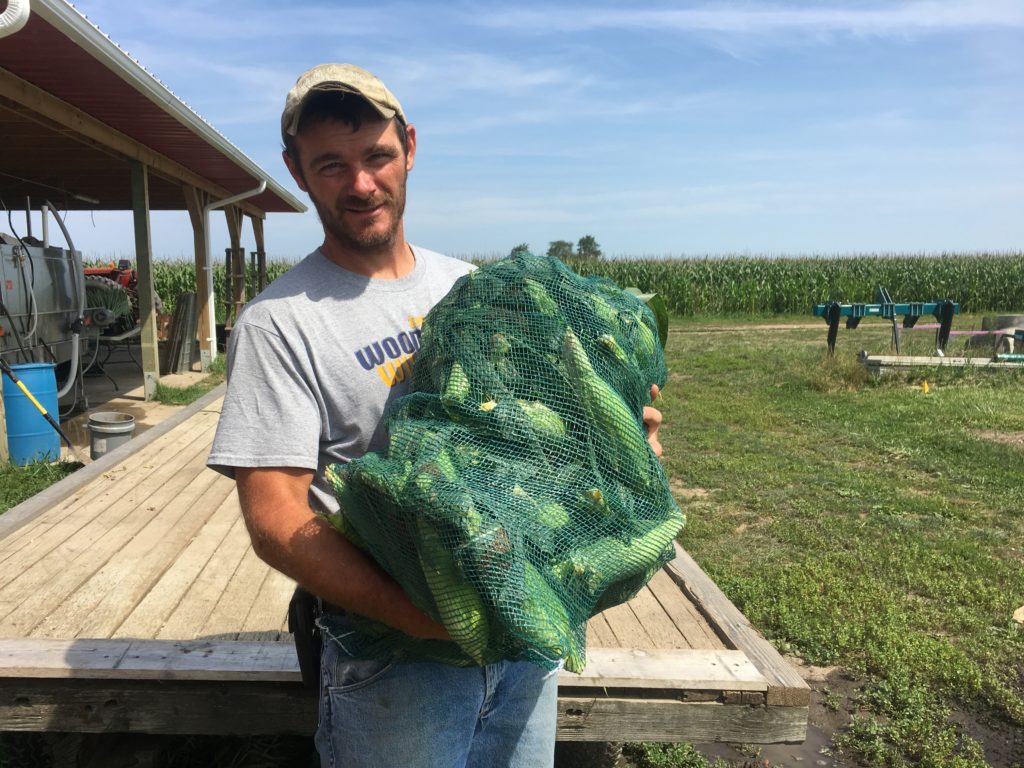
Bulk corn comes in a bag like this of 5 dozen ears for $30
WEEK 8 ANNOUNCEMENTS
- Reserve your tickets for the final Field to Table dinner with Chef Joseph from Cork & Knife Provisions. Our end-of-year Farm Dinner of the year will take place on September 10th. It will be catered by Cork and Knife Provisions under the watchful eye of Master Chef Joseph (formerly of Degage Restaurant). Tickets will be $75 each. There are currently 65 seats available. See our special article in this newsletter with details and menu. You can reserve your spot here.
- Make sure you read about the Shishito Pepper Challenge happening this week! You’ll get 5 of these in your box, and one of them may be spicy! Post your picture in the Facebook group to enter to win!
- Sweet corn is now available to buy in bulk in our online store! A bushel bag goes for $35 and includes 64 ears. We encourage you to buy your bulk corn in August, because the ears are bigger then. We only have a limited amount of space on our trucks, so if we sell out, just hang on tight and be ready to order next week.
- You can order additional items from the Shared Legacy Farms online store. Our store link is super easy to remember: www.sharedlegacyfarms.com/store. Just be sure to select the right pickup site that coincides with your pickup location. If the pickup option is greyed out or not available, it means you missed the window to order. You need to place your order 36 hours before your site. We harvest the product on Monday and Wednesday mornings — early. This week, the store will have: sweet corn, bulk sweet corn, jalapenos, Shishito peppers, candy stripe beets, golden beets, red beets, red, orange, or yellow seedless watermelons, dinosaur kale, green cabbage, summer squash, blonde pickling cucumbers, dill flower bunches, yellow peaches, donut peaches, carrots (loose), parsley, along with my brother Arik’s honey, local maple syrup, and a few extra eggs from Jed/Josiah.
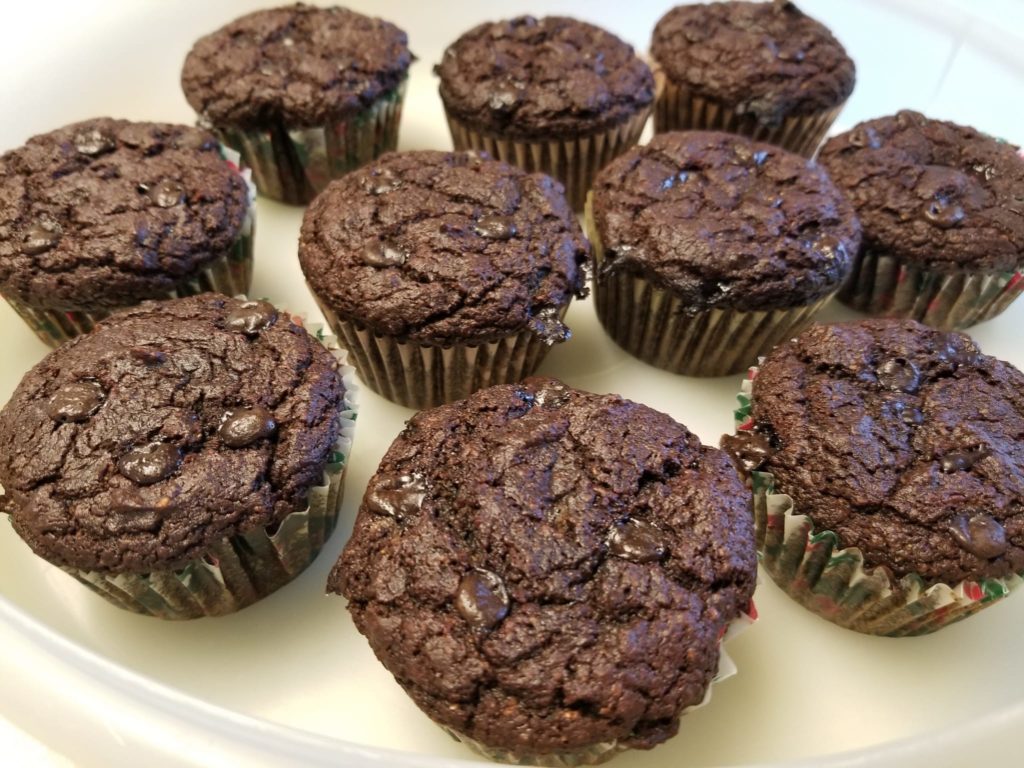
Elaine Hogan shared this picture of her chocolate beet muffins she baked! Did you cross this off your Bingo board yet?
WEEK 8 CSA RECIPES
Members: You can download these recipes as a PDF. These recipes are designed to inspire you to use your box this week! Please check inside our private Facebook group to find your fellow members sharing ideas for what to make with their box! Share a photo and you might be featured in next week’s newsletter!
Zucchini Noodle Salad with Parsley Pistachio Pesto
Parsley Garlic Butter
Super Ramen with Kale and Barbecue Mushrooms
Chinese Eggplant with Spicy Garlic Sauce
Skillet Corn Medley with Peppers
Baked Orzo with Eggplant and Mozzarella
Zucchini Pizza Boats
Roasted Chicken with Clementines and Arak (uses FENNEL)
Roast Chicken Cacciatore with Red Wine Butter (uses FENNEL)
Orange and Fennel Salad
Blistered Shishito Peppers
Blistered Shishito Peppers in the Air Fryer
Pasta with 15-minute Burst Cherry Tomato Sauce
Corn and Potato Chowder
Garlic and Parsley Potatoes
Iced Cantaloupe Soup with Jalapeno and Basil
Cantaloupe Peach Salad with Mozzarella
Spicy Honey Glazed Pork Chops with Peach Pico De Gallo

